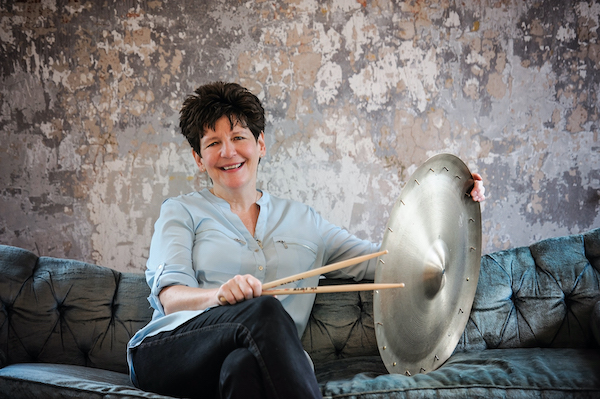Dec 9, 2025 12:28 PM
In Memoriam: Gordon Goodwin, 1954–2025
Gordon Goodwin, an award-winning saxophonist, pianist, bandleader, composer and arranger, died Dec. 8 in Los Angeles.…

Drummer Sherrie Maricle’s latest effort is 3Divas, a recording with the 3D Jazz Trio, which also includes bassist Amy Shook pianist Jackie Warren.
(Photo: Courtesy Of Artist)How did you meet and end up working with Stanley Kay, who originally founded The DIVA Jazz Orchestra?
It’s perfect timing to ask me that question, because May 12 [was] the 30-year anniversary of when I met Stanley Kay.
I had a fun job with a full symphony orchestra, and then in comes Stanley Kay with the great singer and dancer Maurice Hines; Stanley was conducting for Maurice. I’m like, “Oh, my God, that’s Stanley Kay, the man that was with Buddy Rich all those years.” For two years, I did stay in touch with him. I invited him to my gigs, which he never came to. [laughs] But he did call me up in the spring of 1992, and he said, “You know, I think I want to get back into the band business. Do you know women who play like you?”
I took that as a big compliment.
At that time, how were things in general for women jazz musicians?
I don’t know what all women were going through at the time.
There were a number of all-women groups in New York that concentrated on everything but the music. It was more about, you have to look this way. To me, it was degrading in many ways. No single woman artist that I’ve ever known in my life would have [looks] as a priority above learning the music and being reverent about everything surrounding it.
How have you seen the #MeToo movement working within the larger jazz community?
Things were happening to me [as a young woman] that were insane, like my teachers hitting on me or being spoken to with outrageous nonsense.
I was fired off a gig with Rodney Dangerfield, the famous comedian, before I played a note, because I walked in for the gig and they were like, “Oh, you’re a woman. No.” More brutal than that were the constant come-ons. I don’t know a single woman jazz musician that hasn’t gone through that at some point, whether it be via a teacher or a colleague. But women in their 20s are saying things to me and experiencing things that happened to me when I was in my 20s. I’m like, “Still, really? I can’t believe it. Why?”
There are a lot of stories now where young women are feeling empowered to say, “You know, that’s just not right on any level,” whereas I and a lot of women [of my generation] would just brush it off and forge ahead. Now, [women have] the ability to look someone square in the face and say, “Stop it! If you wouldn’t do it to your male colleague, you will not do it to me.”
Can you reflect on how becoming an advocate for women in jazz has impacted your life and career?
I think I became an advocate by default. Now, I’m actually much more aware in that regard. I really like giving women artists an opportunity to perform. Any place we go, young women—and much older women—have been in tears, [saying] “We never thought that we would see women playing like this.”
In Atlanta, specifically, the head of the theater where we played said to me, “There’s no women that play like that; there’s no women that play jazz here.”
For some reason, at this point in time, which was 2014, that made me so angry. I felt my face—have you ever gotten so mad, you felt your cheeks flush? So, from that point, I was going to unearth every opportunity to help every woman who plays their ass off as much as I can for the remainder of my career. Because today, in 2020, people still don’t think that women can play traditional jazz instruments. It’s crazy.
Do you ever wonder how your life would have been different if Kay hadn’t called you?
No one’s ever asked me that. Also, that night, besides meeting Kay and Maurice Hines, I met Skitch Henderson, who was the primary conductor [for that show]. He hired me to play in the symphonic pops orchestra in New York; it has a regular season at Carnegie Hall. I’ve been in The New York Pops for 30 years. All that happened on May 12, 1990. I feel like that was my night, for some reason.
DIVA ... literally, that band has been half of my life. Man, now you’re going to have me thinking about this for the rest of the day. DB

Goodwin was one of the most acclaimed, successful and influential jazz musicians of his generation.
Dec 9, 2025 12:28 PM
Gordon Goodwin, an award-winning saxophonist, pianist, bandleader, composer and arranger, died Dec. 8 in Los Angeles.…

Belá Fleck during an interview with Fredrika Whitfield on CNN.
Jan 13, 2026 2:09 PM
The fallout from the renaming of the John F. Kennedy Center for the Performing Arts to include President Donald…

Flea has returned to his first instrument — the trumpet — and assembled a dream band of jazz musicians to record a new album.
Dec 2, 2025 2:01 AM
After a nearly five-decade career as one of his generation’s defining rock bassists, Flea has returned to his first…

Dec 11, 2025 11:00 AM
DownBeat presents a complete list of the 4-, 4½- and 5-star albums from 2025 in one convenient package. It’s a great…

“It’s a pleasure and an honor to interpret the music of Oscar Peterson in his native city,” said Jim Doxas in regard to celebrating the Canadian legend. “He traveled the world, but never forgot Montreal.”
Nov 18, 2025 12:16 PM
In the pantheon of jazz luminaries, few shine as brightly, or swing as hard, as Oscar Peterson. A century ago, a…